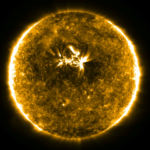Serena Maria Lezzi (2021-2024)
Università degli studi di Napoli Federico II
Abstract:
Active Regions (ARs) on the solar disk are frequently surrounded by annular regions appearing darker than the surrounding quiescent areas. These so called Dark Halos (DHs) are observed during the entire solar cycle and at many spectral wavelengths and wavebands, covering the temperature range typical of almost all the upper solar atmosphere, from the chromosphere to the low corona.
In the chromosphere DHs were shown to coincide approximately with the chromospheric vortex pattern of Hα fibrils that rapidly appears around emerging ARs (e.g. Reardon et al. 2009). It is not clear, instead, why they are observed at wavelengths and wavebands corresponding to transition region and corona (such as the SDO/AIA 171 Å waveband).
More recently, there has been a renewed interest in DHs, as some authors have tried to explain their nature (Wang et al. 2011, Singh et al. 2021). To date, however, no consensus has emerged on this topic. In many respects, DHs are not well characterized in terms of empirical features, despite the potential large database of observations available.
Furthermore, DHs are often mistaken with Coronal Holes (CHs), which are regions of low EUV and X-ray intensities on the solar disk and are known as the main sources of the fast solar wind. Therefore further investigation is needed to understand the differences between these two types of dark, large-scale features in the solar atmosphere.
The main aim of this PhD is to study and characterize as much as possible Dark Halos around solar active regions. To do so, the research work is trying to answer the following questions:
1. What are the morphological, temporal and emission properties of a DH?
2. What are the differences between DHs and CHs?
3. Is there a relationship between DHs and the outflows observed at the outskirts of ARs?
4. Is DH’s fine structure peculiar compared to the quiet sun or coronal holes?
5. What is the configuration of the magnetic field inside a DH? How is it correlated with the corresponding AR magnetic field?
6. What is the nature of DHs? What causes their low emission? Why do we see DHs in some wavelengths only?
The work involves the analysis of data from current space missions, such as IRIS, SDO, Hinode and Solar Orbiter, with the aim of defining tools for interpreting data from future missions, such as the planned JAXA’s SOLAR-C/EUVST and NASA’s MUSE solar missions.

SDO/AIA 171 Å full-disk image showing the Dark Halo surrounding AR NOAA 12738 on 13 April 2019
Relatori:
- Vincenzo Andretta – INAF OACN
- Maurizio Paolillo – Università degli studi di Napoli Federico II

